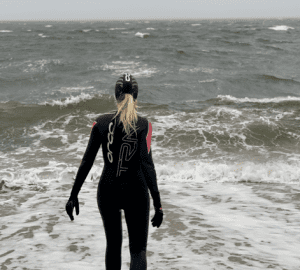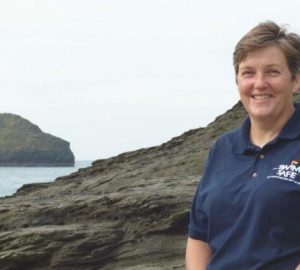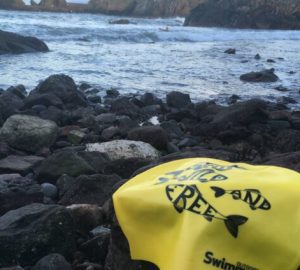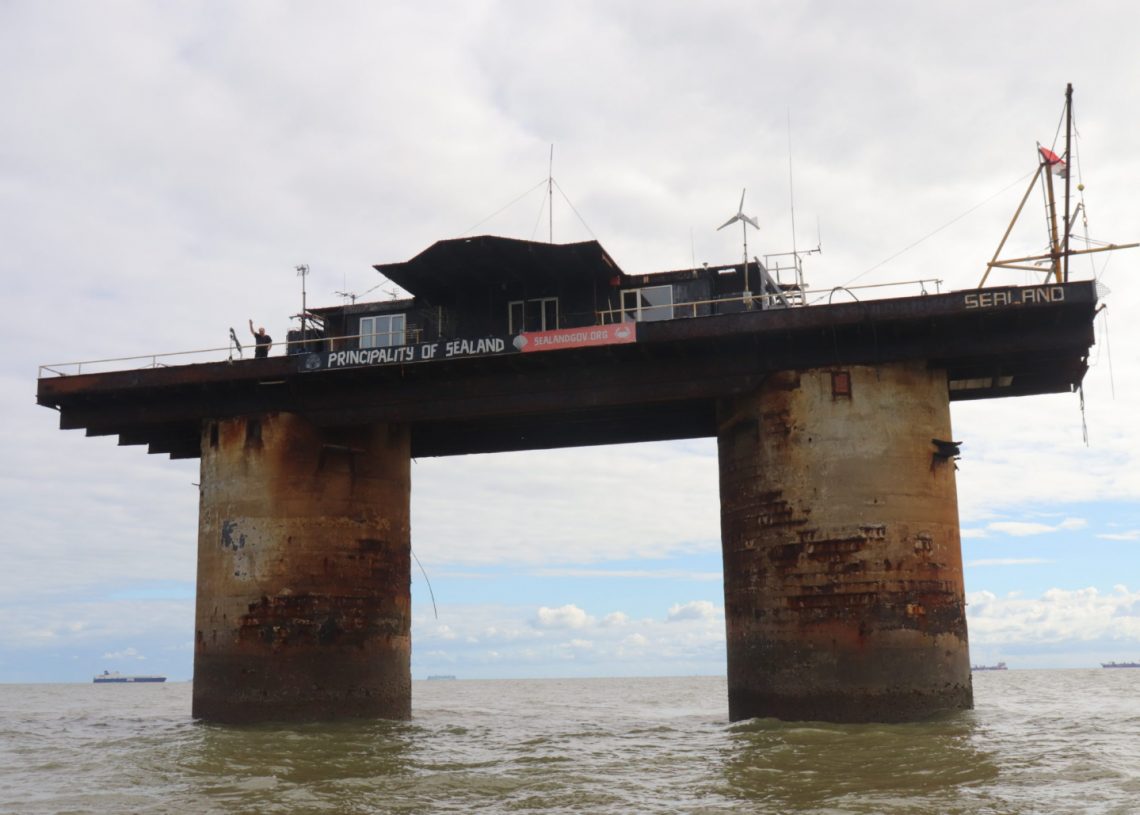
Swim from Sealand
Embark on a unique swim from Sealand, the world’s smallest nation some seven miles off the coast of Suffolk, back to the UK mainland. Jonathan Cowie delves into an eccentric history involving pirate radio stations, armed invasions and attempted coups – and now, a pioneering swim by spinal injury charity, Aspire.
The strange history of the world’s smallest nation some seven miles off the coast of Suffolk is a fascinating study in British eccentricity and a broadside against international maritime law. At turns both absurd and extraordinary, the story of Sealand includes pirate radio stations, armed invasions, attempted coups, fire and kidnapping. Spinal injury charity Aspire have now added open water swimming to that story, with a pioneering swim from the micronation back to the UK mainland.
Sealand’s creation tale begins during the Second World War, when HM Fort Roughs Tower was one of several fortress islands built by the government to defend our coast from German attack. Made of concrete and steel, these nightmarish-looking structures once housed hundreds of men who manned and maintained anti-aircraft weaponry.
Conditions must have been brutal on these lonely maritime outposts surrounded by harsh seas and rough weather. Like several other of the forts, Roughs Tower was built illegally in international waters. Abandoned after the war, the forts were left to decay, visible from the coast on clear days as stark reminders of the dark days of the war. All the other forts built in international waters were subsequently destroyed by the government, leaving Roughs Tower as a single outpost abandoned in the North Sea.
The home of pirate radio
The story of Roughs Tower could have ended there if it wasn’t for the BBC’s refusal to play new-fangled pop music. As pop and rock music took the country by storm, “pirate” radio stations sprang up, the most famous of which was Radio Caroline. Broadcast from a ship in international waters, the radio station operated outside any national jurisdiction and was so able to circumvent British broadcasting regulations.
Another pirate radio station was Radio Essex, run by Roy Bates, a major in the British army, from an off-shore fortress named Knock John. Forced to leave Knock John as it was situated in British waters and therefore subject to British broadcasting laws, Bates looked for alternatives. Close to Knock John, but crucially outside the three-mile limit of British waters, stood Roughs Tower. Bates occupied Roughs Tower on Christmas Eve 1966, ostensibly with the goal of creating a new base for Radio Essex. Soon, however, an even more audacious plan was hatched.
On 2 September 1967, Bates declared the Principality of Sealand. His wife Joan became Princess Joan and the newly-designed red, white and black striped flag was raised. In the following years Sealand minted its own currency (the Sealand dollar, bearing Princess Joan’s head), as well as creating stamps, a coat of arms, passports, national anthem and motto – “E Mare, Libertas”, or “From the sea, freedom”. The world’s tiniest micronation was born, a snub at international law and British sovereignty.
A potential “Cuba off the east coast of England”
Over the years, Sealand has been subject to attempts by the British government to quash the principality as a potential “Cuba off the east coast of England”. Helicopter raids and naval attacks failed to oust the newly-created royal family from their new nation, and an uneasy entente was formed in 1987 when new international laws extended territorial waters from three miles to 12, putting Sealand under British jurisdiction.
In return, Sealand also extended her territorial waters, which now extend to Felixstowe and Harwich. Britain has made no attempt to take Sealand, and likewise Sealand has not occupied Felixstowe. The stalemate persists to this day and the British government treats Sealand as an independent state.
A pioneering swim
The story of the swim from Sealand is thankfully less eventful. Thanks to the involvement and hard work by Aspire in setting up the route and relationships with Sealand and the local marine authorities, the charity is now able to offer the route as both a relay and solo swim.
The genesis of the swim itself is also thanks to Aspire and Richard Royal, who undertook an Aspire Channel relay in 2016. “After an Aspire training weekend in Dover, I was having a conversation with Paul Parrish about swimming challenges that had not yet been attempted, and we mentioned Sealand,” recalls Richard. “I’d been fascinated by Sealand since studying International Relations and always dreamed of visiting, but never considered swimming from it!”
It took two years and a lot of organisation and determination to actually make the swim happen, but in 2018 Richard became the first person to swim the arduous seven miles from the fortress nation back to Felixstowe on the east coast of the UK.
Building on Richard’s experience, Aspire now gives you the opportunity to swim from the world’s smallest nation back to the mainland. At seven miles, this is a challenging swim thanks to strong tides and currents and busy shipping lanes. The route crosses the dredged Felixstowe deep-water channel, which regularly hosts the passage of the largest container ships in the world. Aspire works closely with the Harwich VTS to ensure the safe passage of their swimmers – you wouldn’t want to get in the way of one of those container ships!
Swimming in friendship
Friends Dina Thornton and Jon Wills did the Sealand swim last year as a two-person relay. As locals to Felixtowe, it was a special swim for them as the hulk of the micronation can be seen from the shore on a clear day. “If I was given the chance to do the Sealand swim again I would, especially as it is so close to home,” says Dina. “Living in Felixstowe made it all the more special.”
Jon agrees: “You see it most days and it can look a little bit rough out there. It just kind of grips you and you think, well that’s really interesting, I would like to swim there.”
Although keen swimmers, Sealand was Dina and Jon’s first long-distance open water swim. “As a first ‘big swim’ doing it as a two-person relay made it achievable for me as I was very nervous about being out in the ocean and swimming such a long distance, even though I am an experienced club swimmer this felt like a whole different ball game!” says Dina.
Having the organisation of Aspire on hand made gave Dina the confidence to take on the swim. “For me it was a great experience from beginning to end,” she says. “Aspire were extremely supportive and very approachable at all times. I would definitely do another event if they were involved with it.”
The experience starts with a RIB ride out to the fortress. Slowly through the port at first, the boat then speeds up towards Sealand. “It was a bit nerve-wracking,” says Jon. “The boat takes ages to get there and it’s going really fast. And you’re thinking all the way ‘It’s a long way back!’”
A small dot on the horizon from the shore, up close it’s a different story. “Sealand is huge when you get there,” says Jon. “Massive concrete pillars tower above you.” The strong currents around the fortress pillars made for an exciting start to the swim as Dina got in and battled to swim through the legs of the tower and set off towards the mainland.
After Dina’s first hour, Jon got into the water to take over. His first swim coincided with crossing the shipping lane. “I could see a container ship coming towards me. It was huge!” he says. Confident in Aspire’s constant communication with the Harwich VTS, Jon “just kept swimming” but admits he had a sigh of relief once they got past the shipping lane.
Dina and Jon did another hour of swimming each before hitting land. With a long coastline of potential landings, they were happy to land on the beach where they usually swim with local group the Felixstowe Swimscapes. “It was brilliant,” recalls Jon. “About 25 friends turned up to cheer us on and celebrate with champagne.”
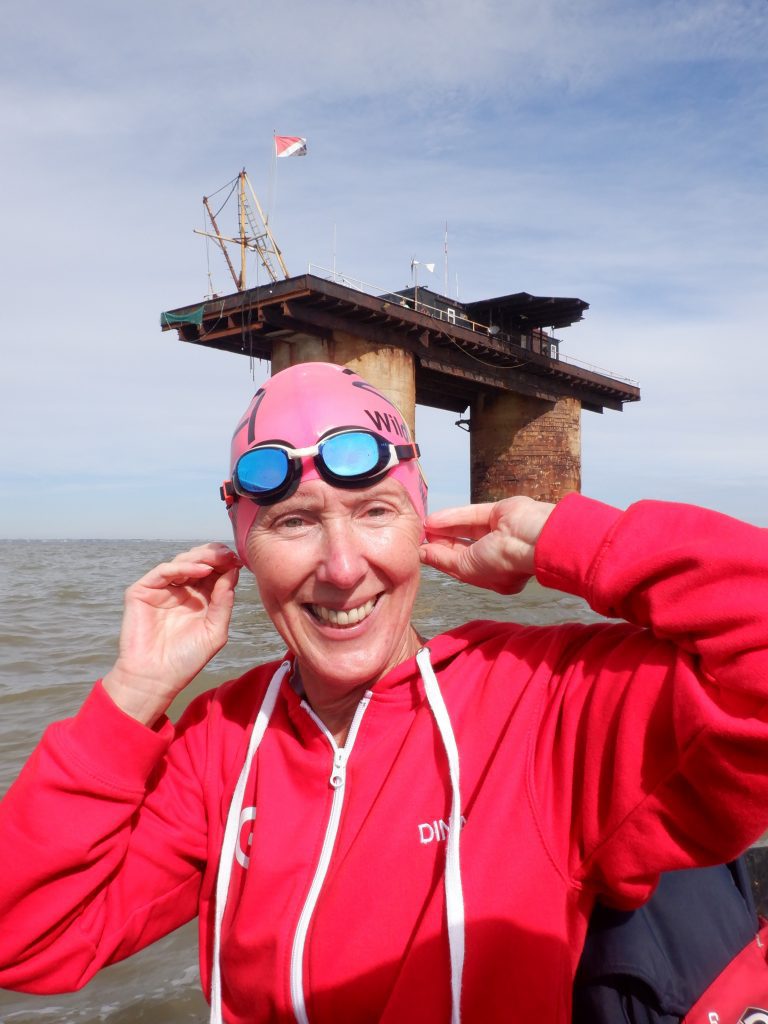
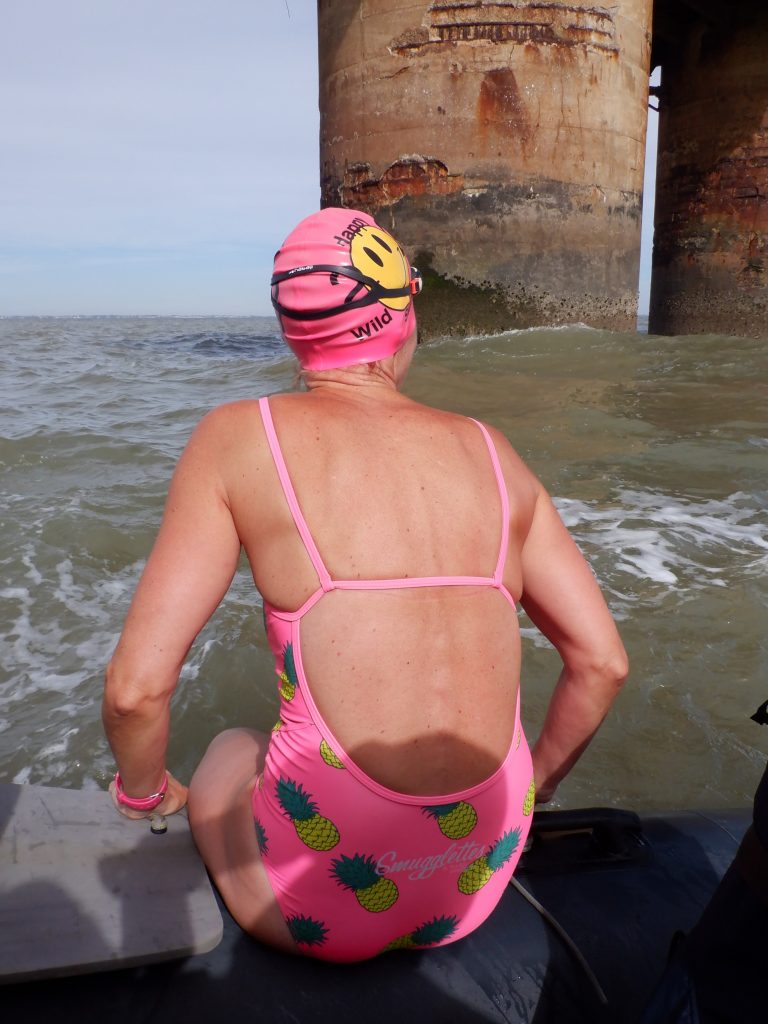
Channel preparation
For experienced swimmer Peter Whitehead, the swim from Sealand was one of many Aspire fundraising swims already under his belt – including the Solent and Channel relays – that culminated in an English Channel last summer.
“It’s really nice to go from A to B when you do an open water swim,” says Peter. “For me the swim ticked three key boxes: a swim I had always wanted to do; supporting Aspire in their fundraising; and a really good training swim for my solo.”
In the roster of Aspire swims, Peter places the Sealand swim between an English Channel relay and a solo. “It is such a nice swim but it’s also quite a demanding swim,” he says. “The east coast is very tidal, so you do get swept in one direction and then back in the other.”
Starting from under the Sealand platform, Peter had the same experience as Dina of being at the mercy of the power of the sea. “It’s quite exciting around the platform,” says Peter. “You get strong currents between the legs of the platform. I remember initially trying to fight before I realised I just had to let the current sweep me behind the platform. You have to remember that you are out in proper open water. People do need to realise that it is a big swim.”
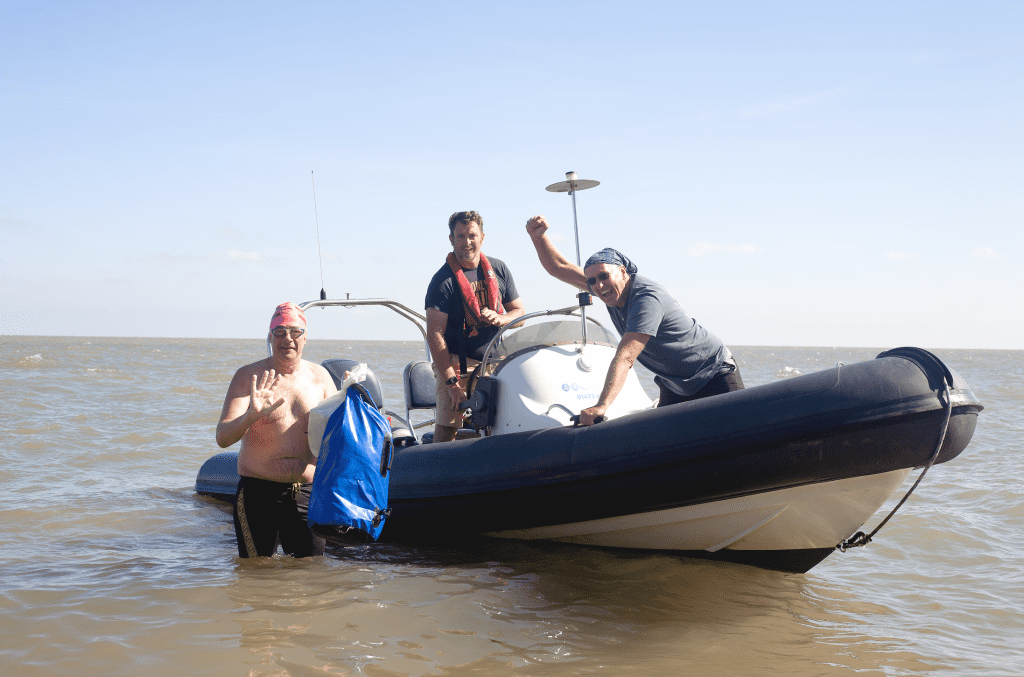
Family and friends were able to track Peter’s swim using the Marine Tracker app, meaning that his wife, daughter and friends were cheering for him on the beach as he landed at Felixstowe. “It was nice to land somewhere and have people waiting for you,” says Peter.
After the swim Peter attended an Aspire dinner where he won a prize in a raffle – a baronet of Sealand. So as well as swimming from Sealand he can now claim to be a member of its aristocracy!
An interesting swim
Philip Brice is a volunteer Aspire English Channel relay boat leader who now also helps support Sealand swims. I ask him what kind of experience you need to take on the Sealand swim. “Realistically it takes someone with experience of swimming in the sea,” he says. “You don’t want them to be upset by the waves and the currents. And also it’s the North Sea. It’s not the Mediterranean in terms of water temperature!”
In terms of classic Channel training swims, Philip places the Sealand swim between a Coniston and a Windermere solo. “But it’s just a lovely swim,” says Philip. “Most of the people doing it probably won’t try Channel solos, but it’s a good, hefty swim nonetheless.”
The location of Sealand makes it a challenging swim to crew for. “There are several tricky, shallow sand banks – some that one can walk over at low tide. And then you have the main channel, which is dredged out so that the largest ships in the world can come into Felixstowe,” says Philip. “You’ll have a hard bit against the tide, and then you’ll get a nice, easy flat bit. Then suddenly it will get choppy and then less choppy, and so on. So it’s an interesting swim!”
If you are interested in taking on the once in a lifetime challenge of swimming from Sealand, check out the Aspire website or email paul.parrish@aspire.org.uk to register your interest. Read more fascinating features on the Outdoor Swimmer website.
Photos: Jon Wills, Peter Whitehead, Jon and Dina
To see all the online content from the February 2023 issue of Outdoor Swimmer, visit the 'Challenge' page.





